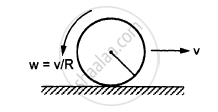Advertisements
Advertisements
Question
A man stands on a rotating platform, with his arms stretched horizontally holding a 5 kg weight in each hand. The angular speed of the platform is 30 revolutions per minute. The man then brings his arms close to his body with the distance of each weight from the axis changing from 90cm to 20cm. The moment of inertia of the man together with the platform may be taken to be constant and equal to 7.6 kg m2.
(a) What is his new angular speed? (Neglect friction.)
(b) Is kinetic energy conserved in the process? If not, from where does the change come about?
Solution
a) 58.88 rev/min
Moment of inertia of the man-platform system = 7.6 kg m2
Moment of inertia when the man stretches his hands to a distance of 90 cm:
2 × m r2
= 2 × 5 × (0.9)2
= 8.1 kg m2
Initial moment of inertia of the system, `I_i = 7.6 + 8.1 = 15.7 kg m^2`
Angular speed, `omega_i = 300 "rev/min"`
Angular momentum, `L_i I_iomega_i = 15.7 xx 30 ....(i)`
Moment of inertia when the man folds his hands to a distance of 20 cm:
2 × mr2
= 2 × 5 (0.2)2 = 0.4 kg m2
Final moment of inertia, `I_i = 7.6 + 0.4 = 8 kg m^2`
Final angular speed = `omega_i`
Final angular momentum, `L_i = I_iomega_i = 0.79omega_i ...(ii)`
From the conservation of angular momentum, we have:
`I_iomega_i = I_iomega_i`
`:.omega_i = (15.7 xx 30) = 58.88 rev/min`
b) No
Kinetic energy is not conserved in the given process. In fact, with the decrease in the moment of inertia, kinetic energy increases. The additional kinetic energy comes from the work done by the man to fold his hands toward himself.
APPEARS IN
RELATED QUESTIONS
A body is uniformly rotating about an axis fixed in an inertial frame of reference. Let \[\overrightarrow A\] be a unit vector along the axis of rotation and \[\overrightarrow B\] be the unit vector along the resultant force on a particle P of the body away from the axis. The value of \[\overrightarrow A.\overrightarrow B\] is _________.
A particle moves with a constant velocity parallel to the X-axis. Its angular momentum with respect to the origin ____________.
A person sitting firmly over a rotating stool has his arms stretched. If he folds his arms, his angular momentum about the axis of rotation ___________ .
If there is no external force acting on a nonrigid body, which of the following quantities must remain constant?
(a) angular momentum
(b) linear momentum
(c) kinetic energy
(d) moment of inertia.
A disc rotates about its axis with a constant angular acceleration of 4 rad/s2. Find the radial and tangential accelerations of a particle at a distance of 1 cm from the axis at the end of the first second after the disc starts rotating.
A uniform square plate of mass 2⋅0 kg and edge 10 cm rotates about one of its diagonals under the action of a constant torque of 0⋅10 N-m. Calculate the angular momentum and the kinetic energy of the plate at the end of the fifth second after the start.
Two particles of masses m1 and m2 are joined by a light rigid rod of length r. The system rotates at an angular speed ω about an axis through the centre of mass of the system and perpendicular to the rod. Show that the angular momentum of the system is \[L = \mu r^2 \omega\] where \[\mu\] is the reduced mass of the system defined as \[\mu = \frac{m_1 + m_2}{m_1 + m_2}\]
Suppose the rod with the balls A and B of the previous problem is clamped at the centre in such a way that it can rotate freely about a horizontal axis through the clamp. The system is kept at rest in the horizontal position. A particle P of the same mass m is dropped from a height h on the ball B. The particle collides with B and sticks to it. (a) Find the angular momentum and the angular speed of the system just after the collision. (b) What should be the minimum value of h so that the system makes a full rotation after the collision.
A uniform wheel of radius R is set into rotation about its axis at an angular speed ω. This rotating wheel is now placed on a rough horizontal surface with its axis horizontal. Because of friction at the contact, the wheel accelerates forward and its rotation decelerates till the wheel starts pure rolling on the surface. Find the linear speed of the wheel after it starts pure rolling.
A solid sphere is set into motion on a rough horizontal surface with a linear speed ν in the forward direction and an angular speed ν/R in the anticlockwise directions as shown in the following figure. Find the linear speed of the sphere (a) when it stops rotating and (b) when slipping finally ceases and pure rolling starts.

